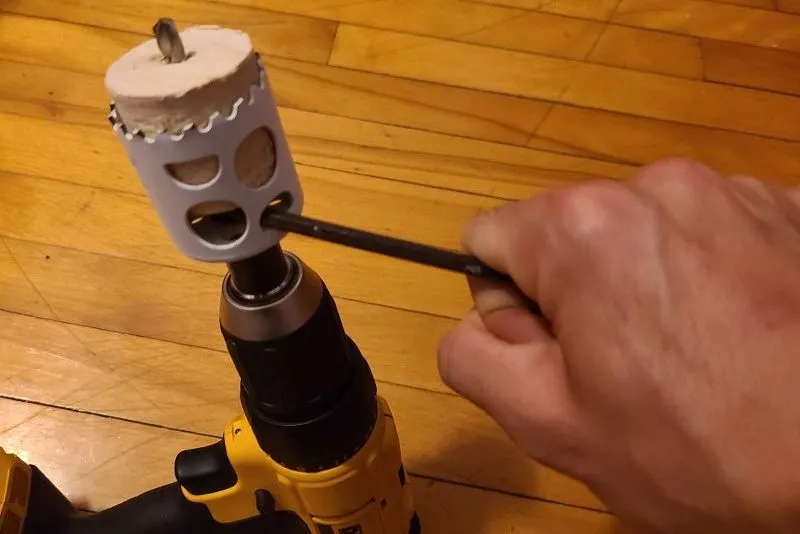Removing a piece of wood stuck in a hole saw can be a bit tricky, but there are several methods you can try to safely and effectively get the wood out. Here’s a step-by-step quick guide:
- Wear safety gear.
- Let the saw cool down if it’s hot.
- Try tapping and rotating the hole saw gently.
- Use a chisel for a plunge cut if needed.
- Use pliers or a vice grip to grab and twist the wood.
- Apply lubricant and wait before attempting to remove.
- Drill a pilot hole if necessary.
- Be patient and avoid using excessive force to prevent damage or injury.
How to safely cool down a hot hole saw?
By adhering to these initial steps of allowing the hole saw to cool down and wearing appropriate safety gear, you establish a safe and controlled environment for tackling the task of removing wood from the hole saw.
Allow the hole saw to cool down
When a hole saw has been used for cutting wood, it can become quite hot due to the friction generated during the cutting process.
Allowing the hole saw to cool down is essential for several reasons:
- Safety: Handling a hot tool can lead to burns or accidents. Waiting for it to cool ensures your safety.
- Easier handling: A hot hole saw can be challenging to grip and manipulate effectively. Cooling it down makes it more manageable.
- Prevents damage: Rapid temperature changes, such as exposing a hot tool to cold water, can damage the tool. Allowing it to cool naturally avoids this risk.
To cool down the hole saw, simply set it aside in a safe place and wait for it to reach room temperature. This can take a few minutes depending on how hot it has become.
Wear appropriate safety gear:
Safety gear is crucial when working with power tools or handling potentially hazardous situations, such as removing wood from a hole saw. Here’s a breakdown of the necessary safety gear:
- Safety glasses: Protect your eyes from flying wood particles, debris, or any potential accidents.
- Gloves: Wear durable gloves with good grip to protect your hands from splinters, sharp edges, or hot surfaces.
- Hearing protection (optional): Depending on the noise level of your equipment, wearing ear protection may be necessary to prevent hearing damage.
- Dust mask (if indoors): If you’re working indoors or in an environment with a lot of dust, wearing a dust mask can help you avoid inhaling harmful particles.
- Appropriate clothing: Avoid loose-fitting clothing that can get caught in the equipment. Wear closed-toe shoes for foot protection.
Safety gear not only safeguards you from immediate dangers but also reduces the risk of long-term health issues associated with exposure to dust, noise, and repetitive motion.
How to use a chisel to remove wood from a hole saw?

Remember to exercise patience and caution when using these basic removal methods, and avoid using excessive force to prevent damage to the hole saw or potential injuries.
Tap and rotate the hole saw
This method involves using gentle tapping and rotational movements to free the stuck wood.
After allowing the hole saw to cool down and ensuring safety gear is in place, follow these steps:
- Hold the hole saw firmly, ensuring it’s stable and secure.
- Gently tap the hole saw against a solid surface, like a workbench or the edge of your work area.
- Simultaneously, try rotating the hole saw back and forth while applying slight pressure.
- The tapping helps to dislodge the wood by breaking it loose, while the rotational movement helps to create space for the wood to come free.
- Be patient and persistent, as it may take some time to remove the wood completely.
Plunge cut with a chisel
This method involves using a chisel to create a cut in the stuck wood, allowing for easier removal.
After allowing the hole saw to cool down and ensuring safety gear is in place, follow these steps:
Select a chisel that is narrow enough to fit between the teeth of the hole saw without damaging them.
Position the chisel at an angle inside the hole saw, ensuring it digs into the wood. Gently tap the chisel with a mallet or hammer while applying slight pressure.
The goal is to create a cut or groove in the wood, which will weaken its grip on the hole saw.
Exercise caution to avoid damaging the teeth of the hole saw or injuring yourself.
Final Words
In conclusion, we’ve covered important steps for dealing with a common challenge: getting wood out of a hole saw. We began by emphasizing the need to prioritize safety through initial steps like allowing the tool to cool down and wearing appropriate safety gear.
Then, we explored basic removal methods, such as tapping and rotating the hole saw, making a plunge cut with a chisel, using pliers or vice grips, and applying lubrication.
Remember, patience and caution are key throughout this process to ensure both your safety and the preservation of your tools.
